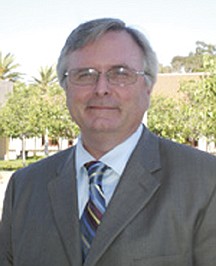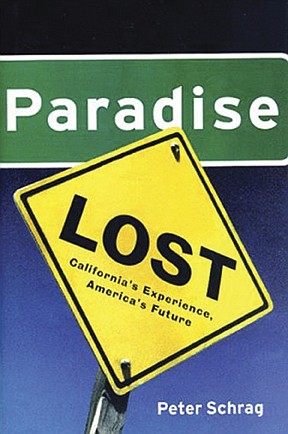 Facebook
Facebook
 X
X
 Instagram
Instagram
 TikTok
TikTok
 Youtube
Youtube

People living on the west side of Chula Vista face distinct problems from those living on the Mello-Roos side of the city. Those who see the glass as half-empty see the western part of the city as old and impoverished, with sparse, dry-grass parks and a main street past its prime.
Glass-half-full people see the west side’s larger lots, no Mello-Roos fees, a bayfront on the verge of development, a lavish police station and city hall, a quicker commute, and cooling bay breezes.
But no matter what’s in your glass, you see a stark difference when you drive from the east side of Chula Vista to the west.
In his thesis “California Dreamin,’” native Chula Vistan and Stanford University student Gerald Hanono argues that the Mello-Roos act “created private tax districts that would be exploited by developers as they sought to minimize the risk of real estate development…. Most importantly, Mello-Roos funded the construction of ‘public’ infrastructure in these new areas, which only added to a city’s maintenance burden.”

Is a Mello-Roos area then an island, sufficient unto itself? Chula Vista assistant city manager Gary Halbert confirmed in an August 30 interview that the initial cost of infrastructure in the eastern portion of the city was paid for with Mello-Roos bonds. When asked if the Mello-Roos taxes pay for the maintenance of the infrastructure — such as maintenance for roads — Halbert stated that the taxes from the whole city are used to maintain the basic infrastructure. Mello-Roos funds, however, do pay for things that are beyond the normal services — such as maintaining special landscaping.
Most Chula Vistans will agree that with the establishment of Mello-Roos districts predominantly on the east side, the division between east and west Chula Vista deepened. In “California Dreamin,’” Hanono argued: “Although certain sections of the community celebrate them, Chula Vista’s master-planned projects, and the developers who planned and built them, have contributed to expanding inequality in the city and have led to the consolidation of poverty in the area west of I-805.”
The sense of being one city with a common future has broken down. Hanono points out in his thesis that Chula Vista communities often refer to themselves by their Mello-Roos development names. People will say, “I’m from Eastlake” as opposed to “I’m from Chula Vista.”
But Eastlake is not a city. It is a subdivision inside Chula Vista, and city hall and the police department for the Mello-Roos developments are located on the west side of the city.

In Paradise Lost, Peter Schrag writes about the breakdown of community identity in California following the Mello-Roos act: “Once your city requires you to pay what is, in effect, an entry fee for schools, roads or the view, you’re not likely to think of your community and its facilities in the same generous spirited way that people used to. A public park becomes one bought and paid for by you and your neighbors.”
Evidence of deep separation is reflected in the school districts. Chula Vista Elementary School District will be asking voters to say yes to a bond proposition in November. As bonds go, Proposition E is a modest general obligation bond. It asks the west-side voters for $90 million to improve 31 out of 44 elementary schools in Chula Vista. The schools for the most part were built between 1938 and 1975.
The bond doesn’t ask to rebuild schools, put in new playgrounds, or overhaul cafeterias; it just asks to make classrooms wireless and to repair and/or replace things such as heating, ventilation, and air-conditioning for 31 of the oldest schools in the district.
But the remarkable thing about this bond is it excludes the Mello-Roos district voters and the 13 schools built with Mello-Roos money. Only the voters from district one, which is on the west side, will be asked to approve this bond.
One west-side politician worries about the precedent this proposition is setting.
Willard “Doc” Howard, who is running for the Chula Vista Elementary School District board in November, says he has reservations about the bond’s purpose. He thoroughly agrees that west-side schools need attention, “But they need something more than wiring that will serve a technological program for maybe 15 years before there is another technological shift. I believe some of these schools are so old, they simply need to be rebuilt.”
But Howard is even more concerned about the fact that for the first time only a portion of the city is being asked to vote on a bond. “My guess is the Mello-Roos residents are being excluded to ensure that the bond will pass, but we’re setting up for an unhealthy dynamic — a tug-of-war between the two sides. What happens when the schools on the east side age 15 years down the line — and the Mello-Roos bonds are paid off? The west side is going to say, ‘You didn’t vote for, or pay for, our school bond, so why should we vote for yours?’”
I spoke with two representatives of the Chula Vista Elementary School District on August 29: Anthony Millican, communications officer, and Oscar Esquivel, executive director of fiscal services.
Millican said he was sensitive to the fact that the schools on the west side are not on a par with the schools on the east side. He said, “In the best possible world, we would be able to create a level playing field.” But for now, Millican points out that the district at least wants to offer the students the same technological benefits — wireless classrooms — so they can move forward into the 21st Century.
Millican also points to west-side schools like Rosebank Elementary that still have single-pane, wood-frame windows. “We’re not talking about solar power, we’re talking about something as basic as weather-proofing.”
Millican believes Proposition E has a good chance of passing because of something he calls “the trust factor.” Chula Vista Elementary has a track record of being fiscally responsible, and Millican points proudly to the fact that test scores all across the district continue to rise. In August, the district announced that, based on the results of California standardized tests, students in the district were well ahead of proficiency achievement scores for the county and state.
One of the things that figures into the district’s trust factor is the husbandry of Mello-Roos funds. Oscar Esquivel, the district’s executive director of fiscal services, said unequivocally in the August 29 conversation that Chula Vista Elementary only spends Mello-Roos funds in Mello-Roos facilities districts. Moreover, in response to a follow-up email question, both Millican and Esquivel averred, “Our District does not transfer funds from the Mello-Roos pot to help meet cash obligations.”
This is in contradistinction to Sweetwater Union High School District. At a recent meeting, former Sweetwater chief financial officer Dianne Russo told the assembled group that the district had borrowed $67 million from Mello-Roos monies to make payroll.
One irony about Chula Vista’s great divide is that many of the east-side interviewees commented that their parents or grandparents live on the west side. Will that be the tie that binds?


People living on the west side of Chula Vista face distinct problems from those living on the Mello-Roos side of the city. Those who see the glass as half-empty see the western part of the city as old and impoverished, with sparse, dry-grass parks and a main street past its prime.
Glass-half-full people see the west side’s larger lots, no Mello-Roos fees, a bayfront on the verge of development, a lavish police station and city hall, a quicker commute, and cooling bay breezes.
But no matter what’s in your glass, you see a stark difference when you drive from the east side of Chula Vista to the west.
In his thesis “California Dreamin,’” native Chula Vistan and Stanford University student Gerald Hanono argues that the Mello-Roos act “created private tax districts that would be exploited by developers as they sought to minimize the risk of real estate development…. Most importantly, Mello-Roos funded the construction of ‘public’ infrastructure in these new areas, which only added to a city’s maintenance burden.”

Is a Mello-Roos area then an island, sufficient unto itself? Chula Vista assistant city manager Gary Halbert confirmed in an August 30 interview that the initial cost of infrastructure in the eastern portion of the city was paid for with Mello-Roos bonds. When asked if the Mello-Roos taxes pay for the maintenance of the infrastructure — such as maintenance for roads — Halbert stated that the taxes from the whole city are used to maintain the basic infrastructure. Mello-Roos funds, however, do pay for things that are beyond the normal services — such as maintaining special landscaping.
Most Chula Vistans will agree that with the establishment of Mello-Roos districts predominantly on the east side, the division between east and west Chula Vista deepened. In “California Dreamin,’” Hanono argued: “Although certain sections of the community celebrate them, Chula Vista’s master-planned projects, and the developers who planned and built them, have contributed to expanding inequality in the city and have led to the consolidation of poverty in the area west of I-805.”
The sense of being one city with a common future has broken down. Hanono points out in his thesis that Chula Vista communities often refer to themselves by their Mello-Roos development names. People will say, “I’m from Eastlake” as opposed to “I’m from Chula Vista.”
But Eastlake is not a city. It is a subdivision inside Chula Vista, and city hall and the police department for the Mello-Roos developments are located on the west side of the city.

In Paradise Lost, Peter Schrag writes about the breakdown of community identity in California following the Mello-Roos act: “Once your city requires you to pay what is, in effect, an entry fee for schools, roads or the view, you’re not likely to think of your community and its facilities in the same generous spirited way that people used to. A public park becomes one bought and paid for by you and your neighbors.”
Evidence of deep separation is reflected in the school districts. Chula Vista Elementary School District will be asking voters to say yes to a bond proposition in November. As bonds go, Proposition E is a modest general obligation bond. It asks the west-side voters for $90 million to improve 31 out of 44 elementary schools in Chula Vista. The schools for the most part were built between 1938 and 1975.
The bond doesn’t ask to rebuild schools, put in new playgrounds, or overhaul cafeterias; it just asks to make classrooms wireless and to repair and/or replace things such as heating, ventilation, and air-conditioning for 31 of the oldest schools in the district.
But the remarkable thing about this bond is it excludes the Mello-Roos district voters and the 13 schools built with Mello-Roos money. Only the voters from district one, which is on the west side, will be asked to approve this bond.
One west-side politician worries about the precedent this proposition is setting.
Willard “Doc” Howard, who is running for the Chula Vista Elementary School District board in November, says he has reservations about the bond’s purpose. He thoroughly agrees that west-side schools need attention, “But they need something more than wiring that will serve a technological program for maybe 15 years before there is another technological shift. I believe some of these schools are so old, they simply need to be rebuilt.”
But Howard is even more concerned about the fact that for the first time only a portion of the city is being asked to vote on a bond. “My guess is the Mello-Roos residents are being excluded to ensure that the bond will pass, but we’re setting up for an unhealthy dynamic — a tug-of-war between the two sides. What happens when the schools on the east side age 15 years down the line — and the Mello-Roos bonds are paid off? The west side is going to say, ‘You didn’t vote for, or pay for, our school bond, so why should we vote for yours?’”
I spoke with two representatives of the Chula Vista Elementary School District on August 29: Anthony Millican, communications officer, and Oscar Esquivel, executive director of fiscal services.
Millican said he was sensitive to the fact that the schools on the west side are not on a par with the schools on the east side. He said, “In the best possible world, we would be able to create a level playing field.” But for now, Millican points out that the district at least wants to offer the students the same technological benefits — wireless classrooms — so they can move forward into the 21st Century.
Millican also points to west-side schools like Rosebank Elementary that still have single-pane, wood-frame windows. “We’re not talking about solar power, we’re talking about something as basic as weather-proofing.”
Millican believes Proposition E has a good chance of passing because of something he calls “the trust factor.” Chula Vista Elementary has a track record of being fiscally responsible, and Millican points proudly to the fact that test scores all across the district continue to rise. In August, the district announced that, based on the results of California standardized tests, students in the district were well ahead of proficiency achievement scores for the county and state.
One of the things that figures into the district’s trust factor is the husbandry of Mello-Roos funds. Oscar Esquivel, the district’s executive director of fiscal services, said unequivocally in the August 29 conversation that Chula Vista Elementary only spends Mello-Roos funds in Mello-Roos facilities districts. Moreover, in response to a follow-up email question, both Millican and Esquivel averred, “Our District does not transfer funds from the Mello-Roos pot to help meet cash obligations.”
This is in contradistinction to Sweetwater Union High School District. At a recent meeting, former Sweetwater chief financial officer Dianne Russo told the assembled group that the district had borrowed $67 million from Mello-Roos monies to make payroll.
One irony about Chula Vista’s great divide is that many of the east-side interviewees commented that their parents or grandparents live on the west side. Will that be the tie that binds?
Comments